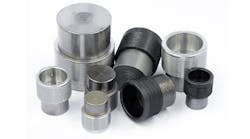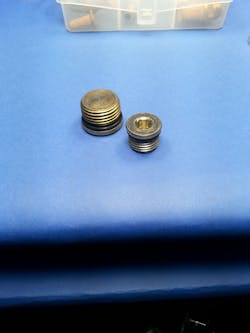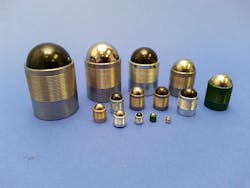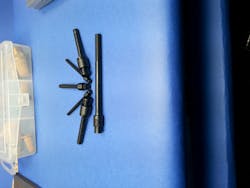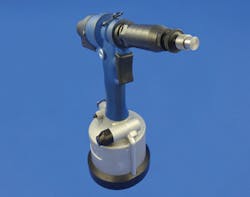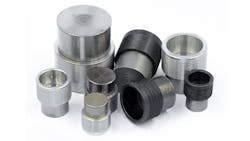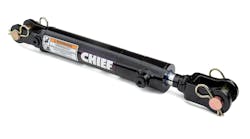Since the first hydraulic systems, engineers were challenged to permanently close off (seal) ends of cross-drilled holes that create flow patterns for actuation. In some cases, they had few options due to the pressures being 3,000 to 5,000-plus psi. Threaded plugs, welding and ball bearings were commonly used, sometimes in combination, to avoid leaks. But these efforts often created more issues than they solved, such as larger manifolds, additional processes, added costs and extra weight.
Ball-style plugs are ball bearings inside of machined can or sleeve plug bodies that started out as a high-pressure, leak-proof, permanent seals. Customers wanted a permanent, easy-to-machine-and-install alternative to costly, often-cross-threaded, SAE-style threaded plugs. The ball plug simplified both machining the hole created to seal the end of the communication path (simple counterbore diam. +0.12 /−0.00), and simplified installation. Users only needed to press the ball a specified distance to assure a leak-proof, permanent seal for pressures up to 6,250 psi (at a 3 to 1 safety factor) or 350 bar.
The ball plugs use a simplified counterbore hole. This lets engineers use smaller holes and, therefore, smaller plugs. The results are reduced size of the applications, decreased weight (mass) and material (cost), and no cross-threading or need for rework.
They are well-suited for low and high-volume installation and adaptable to fully automated installation. Installation for low-volume applications was done with a set tool and hammer or arbor press, tapping or pressing the ball into the sleeve until reaching its final desired position. For higher-volume installation, operators use air hammers to drive the ball into the sleeve. This sped up installation but has some disadvantages. Air hammers are loud, and if an operator slips off the ball with the air hammer, it could damage the manifold’s surface, increasing the scrap rate.
Additional increases in pressures as well as intricate designs required sealing experts to design an alternative to the Ball-style expanders. So, they ruled the sealing industry for years and successfully closed billions of holes until the invention of rivet style expansion plugs in the late 1980s/early 1990s.
Rivet-style plugs simplified the machined hole, so it only needed a straight bore (+0.12 mm/−0), which often resulted in using smaller plugs to seal. The rivet plugs introduced a hydro-pneumatic tool to ensure proper installation. The tool virtually eliminated operator error by relying on the tool to break the plug instead of a technician pressing the ball to the proper depth.
To use it, operators easily insert the plug into the tool, positioned the plug into the hole to be sealed and pressed the trigger while maintaining flush contact with the material. The tool then grabs the mandrel while holding the plug’s body just below the manifold’s surface, drawing the pin into the body until the necked down area of the plug reaches the desired break point. When the pin fully engages the body, it creates the necessary radial expansion and seals the hole. Rivet plugs withstand pressures up to 7,250 psi (at a 3 to 1 safety factor) or 500 bar.
The tool is strongly jolted to break the mandrel which gets sent through the tool and into a collection cylinder for easy disposal. A quick, simple and cost-effective permanent seal, rivet-style plugs were a significant improvement to expansion plugs as a sealing alternative.
These two options—ball and rivet plugs—came in a variety of material choices, sizes, pressure ratings and installation tools and have satisfied hundress of thousands of customers and sealed billions of holes for more than 30 years.
Like ball plugs, rivet plugs had room for improvement. The mandrel used to pull the pin into the body gets thrown away, essentially scraping 25% of the plug just purchased.
Pull-style plugs, invented and patented by EIS in 2013, eliminate the broken mandrels left after installing rivet plugs and reduces customers’ costs. It uses spin pull technology to thread the plug onto a tool’s mandrel until it’s ready to insert into the hole for sealing. The plug goes into a simple hole with straight bore while the tool’s nose keeps the plug body slightly below flush of the material’s surface. The operator presses the trigger and the tool pulls the pin into the plug with a predetermined and consistent stroke. It does not rely on reaching a break force to separate the mandrel as with rivet plugs. The stroke fully expands the plug then reverses its spin to remove itself from the installed plug.
There is no waste as the entire plug rivets in quickly and is securely installed in a simple machined hole—fast and secured installation. The rivet plugs also reduce the piece price and increase manufacturing efficiencies, compared to other sealing methods.
EIS has continued to refine the pull plug. With the mandrel built onto the tooling, for example, users can install the same plug at any depth into the manifold simply by using a longer (interchangeable) mandrel and sleeve on the tool. Because the plug uses an internal thread to pull the pin into the body, by design there is now a usable thread to which customers can attach wire harnesses, name badges or other information. If a flow restriction is needed, the company will drill an orifice through the pin, transforming the pull plug into a secured restrictor.
The plug is made in steel, aluminum, titanium and stainless steel and comes in sizes from 5 to 20 m. There are low-, high- and ultra-high-pressure versions that let it meet the needs of industrial hydraulics, as well as those of the automotive, medical, oil and gas, and aerospace industries, to name a few.
Brian Krieger is sales manager for EIS, Engineered Inserts & Systems Inc.
